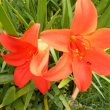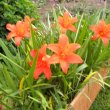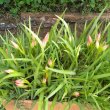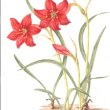| Botanical Name |
|
| Family |
Amaryllidaceae - The amaryllis family. |
| Pronunciation |
sir-TANTH-us san-GWIN-ee-us |
| Common Name(s) |
English: Kei Lily; Inanda lily; Fire lily; Nahoon lily
Afrikaans: Keilelie; Vuurlelie
|
| Plant Group |
- Bulb / Corm / Rhizome / Tuber / Epigeal bulb Bulbs: are made up of fleshy scales as in an onion
Corm: a short, swollen, underground stem that is hard and not fleshy as in a gladiolus
Tuber: a solid, fleshy, underground, storage organ as in a potato
Rhizome: an underground, horizontal, swollen stem at the base of the plant as in an iris
Epigeal bulb: bulbs that rest above the ground with only the roots anchoring the plant to the earth as in albuca
|
| Plant Size |
- Small
| Tree | 4m to 8m |
| Shrub | 50cm to 75cm |
| Perennial/ground cover | 10cm to 20cm |
| Bulb | 20cm to 30cm |
| Succulent | 10cm to 20cm |
|
| Position |
- Canopy Shade Canopy shade is found below closely grown trees where some light filters through. Ideal for the protection of herbaceous plants.
- Light or Dappled Shade Found below trees with sparse, open foliage. Ideal for the protection of herbaceous plants.
- Partial Shade The area is in shade for part of the day and in full sun for part of the day.
|
| General Information |
- Deciduous Plants which completely lose their foliage for part of the year.
- Drought Tolerance: High The plant is well adapted to arid conditions; it can survive long periods of drought and high temperatures without extra water.
- Frost: Tender A plant that will not survive any frost or low winter temperatures.
- Water Loving Plants need a regular supply of water and must not be allowed to dry out for any length of time.
|
| Specific Information |
Cyrtanthus sanguineus produces one or two remarkably striking scarlet flowers on a stem up to 30cm long. Between 1 and 4 narrow, dark green, strap-like leaves accompany the flowers. The bulbs are unexpectedly large, being 10cm in diameter when they reach flowering size.
Beware of mole rats and amaryllis caterpillar!
|
| Ad Break |
|
| Flowers |
| Description |
tubular, from 7 - 10cm long, broadening rapidly into six 'petals' on a stem up to 30cm long
|
| Season |
- Summer to Autumn Plants will seldom bloom for the entire season as given in the list, but should flower during a period within these parameters.
|
| Colour |
|
| Growth Rate |
- Moderate to Fast Specifying growth rate can be very misleading as there is considerable variation of growth rate depending on type and species of plant, available water, supplementary feeding, mulching and general care, as well as the plants suitability and adaptability to the garden environment.
|
| Plant Uses |
- Accent or Focal Point A plant used to attract the attention because of its colour or form.
- Attracts bees, butterflies or other insects This plant attracts insects which can be food for birds or other creatures in your garden.
- Border A strip of ground, at the edge of a driveway or path in which ornamental plants or shrubs are planted.
- Container Trees, shrubs and ornamental species that can adapt to growing in a restricted environment.
- Interplanting Arranging and planting plants in the garden that have different blooming times and habits of growth, extending the amount of time in which the area is in flower.
- Pot Plant A plant that needs a protected environment on a patio or indoors.
- Suitable for coastal gardens Plants adapted to dry, sandy soil, forceful wind, limited rainfall and intense sunlight.
- Water Features These plants may have dramatic, lush foliage or graceful form. They do not shed excessive leaves and do not have invasive root systems.
|
| Distribution and Habitat |
from near Bathurst in the Eastern Cape to KwaZulu-Natal, in rocky places along banks of streams and rivers, and in moist kloofs
|
| Planting Suggestions |
Plant in a well-drained, compost enriched soil mixture, in full sun only if there if there is a constant water supply, alternatively in light shade, preferably facing south. Place the bulbs with the 'shoulder' just below the soil surface. Water regularly throughout summer. In hot, inland areas these bulbs must be shaded from the midday and afternoon sun.
Once established, Cyrtanthus sanguineus will produce many off-shoots and bulblets. (I once planted 32 adult bulbs in a planter and two years later harvested over 300 little bulblets). Avoid disturbing the bulbs for 3 to 4 years as they resent being moved and may not flower during the following season. If in a container, this may need to be done more often - my last container simply burst open at the end of the second year. However, I have noticed that the more crowded they are, the better they flower.
Cyrtanthus sanguineus can be grown from seed but I have had no experience in this as mine have never set seed.
|
| Medicinal Uses |
|
| Ad Break |
|








Comments
Cyrtanthus sanguineus
Pronunciation is sir-TANTH-us not ker-TAN-thus
sir-TANTH-us
Hi Linda. Thanks for your comment. I checked my sources and it appears that both pronunciations are accepted, but I prefer the 'sir' version and have altered the data accordingly.
Cyrtanthus sanguineus
15 July 2013. Yesterday photographed C sanguineus flowering in pink and scarlet forms in the Weenen Nature Reserve.
Pink cyrtanthus
Hi Stanley
I am most envious. I have not come across the pink version here as we are too far south, and in fact have never even seen one. I googled the area - the Weenen Nature Reserve is unexpectedly large - there must be such a wealth of flora.
I would be most appreciative if you would consider sharing even just one of your photos so that I can include it on the website. If you would like to do so, send it/them to my email address. The photo will be acknowledged as yours and watermarked to prevent copying.
Kind regards
Lorraine
Discuss this plant
Share knowledge, ask a question or give an experience.